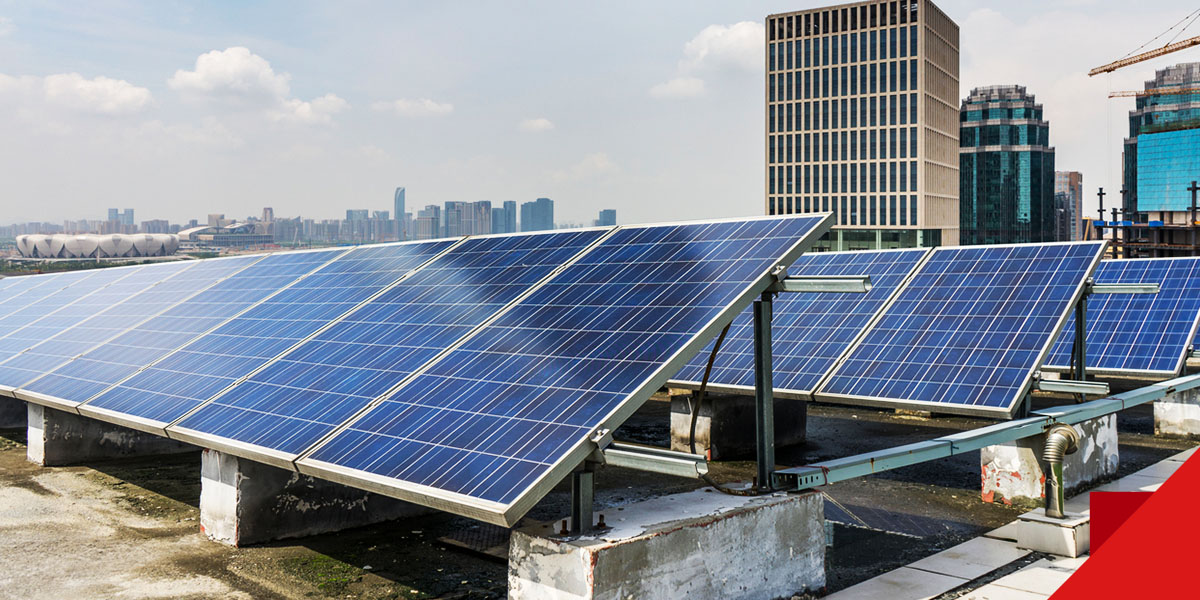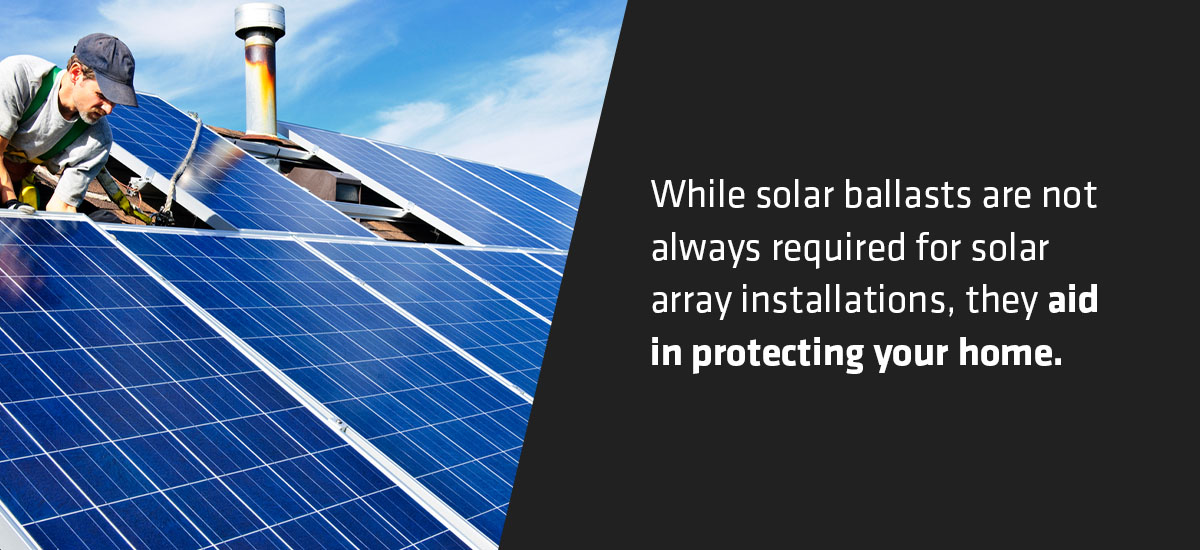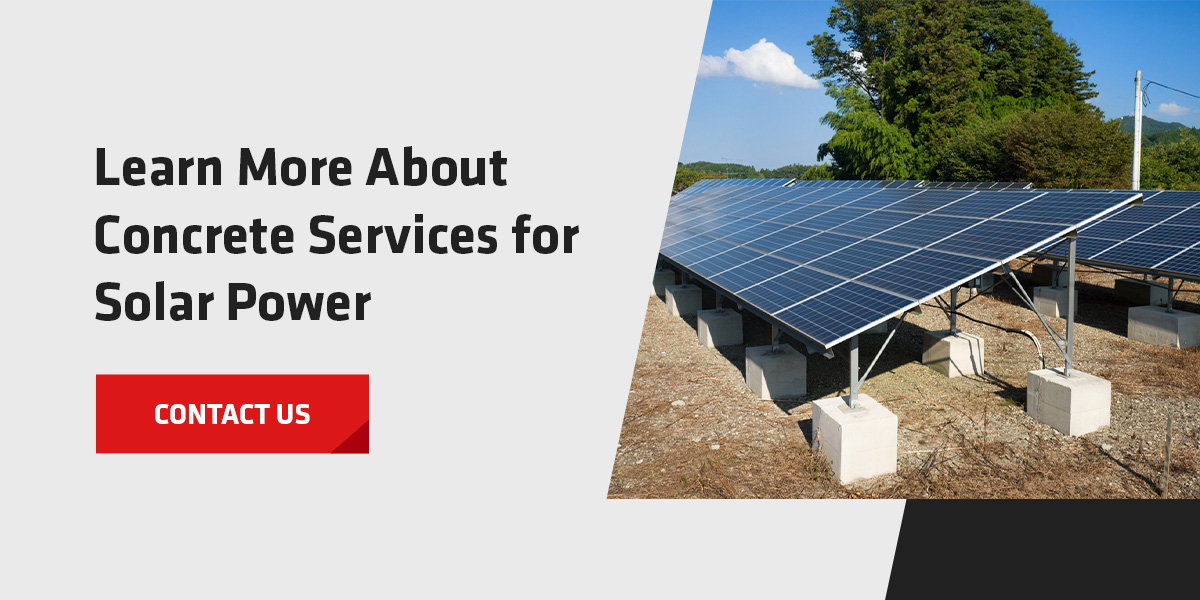Concrete Construction for Solar Energy

How Concrete Construction Supports Solar Energy
Solar power is an expanding industry. More people in the United States have already invested in this energy-efficient solution, and many others are seriously considering it. With more frequent solar array installations, improved technologies must ensure they stay in place at your home or business. The solution? Concrete solar ballasts.
Learn what a solar ballast is, how it works and how concrete can benefit your solar array installations.
What Is a Solar Ballast?
A solar ballast is a mount for solar arrays made from concrete blocks. Traditionally, solar panel and array installations require attaching mounts directly to a home’s roof or the ground by drilling and cutting into it. Alternatively, solar ballasts secure the array to a building’s roof or the ground without requiring holes to penetrate the surfaces. Ballasts also protect the solar arrays by preventing the display from shifting and lifting off the ground or roof on windy days.
Ballasts are located throughout the solar array to ensure plenty of security.
Importance of Solar Concrete Ballasts
While solar ballasts are not always required for solar array installations, they aid in protecting your home. With traditional installations, the contractors drilling holes into your roof ensure they get patched correctly. Still, your roofing system is at a greater risk for leaks and water damage if the spots become unsealed over time. Solar concrete ballasts eliminate the need to create holes, preventing leaks and other issues.
Ballasts suit and are highly recommended for flat-top and low-sloped roofs. The roof styles are more susceptible to damage by traditional means because they lack proper drainage systems without the assistance of gravity. If water were to pile on your roof and one of the holes leaked, the water would enter your home, causing property damage.
Concrete ballasts for solar energy also suit the solar arrays mounted on the ground. They make installation possible in areas where it may have been difficult to install the panels, such as wet or moist areas, and on landfill sites, which are otherwise unusable land.
How Many Ballasts Will You Need?
Your solar array installer will determine how many ballasts are necessary and if special designs will improve the installation. They may consider several factors when deciding the number of ballasts needed for your installation, including:
- The size and arrangement of the solar array itself.
- The location of the solar array, including determining factors like wind and any possible seismic activity.
- The shape of the roof. Is it a flat roof? Is it low-sloped? How much of an angle do you have to work with?
- What type of racking will be used on the array?
- What are the height and strength of the racking?
- The code requirements in each jurisdiction. Different locales often operate under different solar code requirements.
The best person to determine the amount of ballast needed is a licensed structural engineering professional engineer. Many racking companies have a professional engineer on staff, but you can hire a professional engineering consultant who can make the appropriate calculations if they don’t.
WHAT ABOUT BALLAST ON OLDER BUILDINGS?
If you’re going to build a solar array on top of a commercial building or the roof of a home, it isn’t necessarily any more difficult than building an array on the ground on top of a landfill or some other site. But there are factors that you need to consider with the building’s roof that you don’t need to consider on the ground:
- The roof’s warranty. The ground doesn’t have a warranty. But roofs do, and anything you build on a roof must be done with the warranty in mind.
- The age of the building.
- Seismic activity area.
Interestingly, older buildings are probably better prepared to accept a solar array system using concrete ballast. Buildings constructed in the 1950s, ’60s or ’70s feature steel truss structures better equipped to deal with arrays and ballast. Engineers are more concerned with buildings that are 15 to 20 years old. In those years, building codes changed and companies built roofs that would hold only minimum loads. In news stories about roofs that have collapsed because of snow or some other factor, they are frequently roofs that were built during this time. These roofs are not good candidates for solar arrays.
Companies eventually realized the problems they were creating for themselves and made changes so buildings that are 5 to 10 years old, for instance, are better able to deal with the weight of a solar array. As we will explain below, technology has shown that less ballast is needed than previously thought to hold a solar array in place.
TECHNOLOGY AND SOLAR BALLAST
Technology has created even more reasons for using concrete solar ballast. Using wind tunnel analysis, and improving the way that solar panels interconnect, engineers determined that you could use less ballast. Improving the way the panels were interconnected led to improvement in load sharing. Also, when racking companies include wind deflectors on their arrays, the arrays become more aerodynamic.
Why is less ballast important? Many homeowners and commercial building owners worry about having concrete slabs on the roof. They worry about how much weight is on the roof. But knowing that you need less ballast to keep the arrays in place makes homeowners more comfortable with using concrete slabs to secure their solar arrays.
While it is true that you can purchase rectangular-shaped concrete blocks at your local home improvement store, concrete manufacturing companies create specially designed concrete ballast for solar arrays.
For instance, communities near Annapolis, Maryland, wanted to build a solar array on top of a landfill site. State law, however, said that the landfill site could not be disturbed so that meant builders could not use an auger to dig holes to anchor the array. Instead, engineers working with a concrete company came up with a unique solution.
The company built concrete ballast slabs with special grooves. These grooves allowed the builders to lay the cables that would carry the power to the main grid. The design also included spaces for a copper ground loop and other wiring skids. Because pre-cast concrete was used, the builders were able to complete the project much more quickly and save money in the end.
Utility companies also work with concrete companies that do precasting because precasting is an even more efficient method than cast-in-place construction. Engineers and designers can work together to create customized concrete blocks and pads to use on ground sites, such as former landfill sites or areas where the ground is too soft to use a penetration method.
Advantages and Disadvantages of Solar Ballasts
Review the advantages and disadvantages when considering whether solar ballasts are right for you.
Two primary benefits:
- Cost: With solar ballasts, you are less likely to encounter unexpected, costly roof damage expenses. Additionally, labor costs for ballast installation are often lower than the alternative.
- Speed: Ballast installation happens faster than roof penetration. Your experienced installer can construct and install your solar arrays quickly so you can use solar energy and power sooner.
Alternatively, there are also a couple of disadvantages to using solar ballasts, such as:
- Weight: As noted above, commercial roofs constructed during the ’80s and ’90s may not be suitable for solar panels using solar ballast because the roof won’t bear the weight of the concrete. However, technological improvements have led to more possibilities for installing solar ballasts with a smaller load.
- Breakdown of concrete: Exposure to wind, rain, UV light, freezing and thawing — especially if you live in a colder climate — wears down concrete, and that concrete can wear down even faster if you buy it at your local home improvement store. With damaged concrete ballasts, your solar arrays risk further issues, so it’s crucial to use concrete rated for your local environmental conditions.
USING CONCRETE BALLAST FOR GROUND MOUNTS
While concrete ballasts are ideal for flat or low-sloped roofs, they are also an effective solution for ground-mounted systems. As we noted above, landfills that have been sealed off are ideal places to use concrete ballast. More communities choose former landfill sites to build solar power arrays these days because nothing else can be built on the site. Solar arrays built on landfill sites provide communities with a way to generate renewable energy while using land unavailable for other purposes.
Concrete ballast also works very well in areas that are too moist or wet for ground penetration to work effectively. Corporate ballast also works in “brownfields” — areas that contain contaminated soil. You don’t want to disturb the contaminated soil, so concrete ballast is the best answer.
Finally, solar displays that are planned for rocky areas also benefit from the use of concrete ballast. You can try to drive posts into the ground in rocky areas, but there’s a better-than-even chance you’re going to hit a rock beneath the surface.
Ballast ground mounts can be more expensive than penetration systems, but once again, what you save in labor costs makes the two systems financially comparable.
EVEN HOGWARTS USES CONCRETE BALLAST TO MAINTAIN IT SOLAR ARRAYS
Well, it’s not exactly Hogwarts, but Gloucester Cathedral in Gloucestershire, England, was depicted as Hogwarts in several of the Harry Potter films. The cathedral, built in the seventh century, recently installed a solar array on its roof using concrete ballast to hold the array in place because the guardians of the cathedral did not want to penetrate the roof. Working with a local concrete company, the solar installers designed a unique system to hide the concrete ballast so it did not obscure any views of the church.
While the story is interesting on one level because of its connection to the Harry Potter films, for our purposes, it illustrates how concrete ballast can be used in the most extraordinary places to ensure that solar arrays remain in place without having to penetrate roofs. Even ancient ones.
Whether you have a commercial building with a flat top roof, a home with a flat or sloping roof, or even a roof on a historic building, if you want to install solar arrays to generate renewable energy, concrete ballasts are the choice to make. Easy to install, cost-effective and durable, concrete ballast means deploying solar power for your home or business is much more within your grasp.
Learn More About Concrete Services for Solar Power
Concrete serves many purposes, including supporting solar array installations. If you need solar concrete ballasts for your solar arrays, ensure you get ones customized to your building’s needs and allowances. R. J. Potteiger Construction Services, Inc. provides concrete services for multiple applications.
Get in touch with a representative through our contact form to learn more about our services and how we can provide concrete ballasts or structures for your solar displays.





